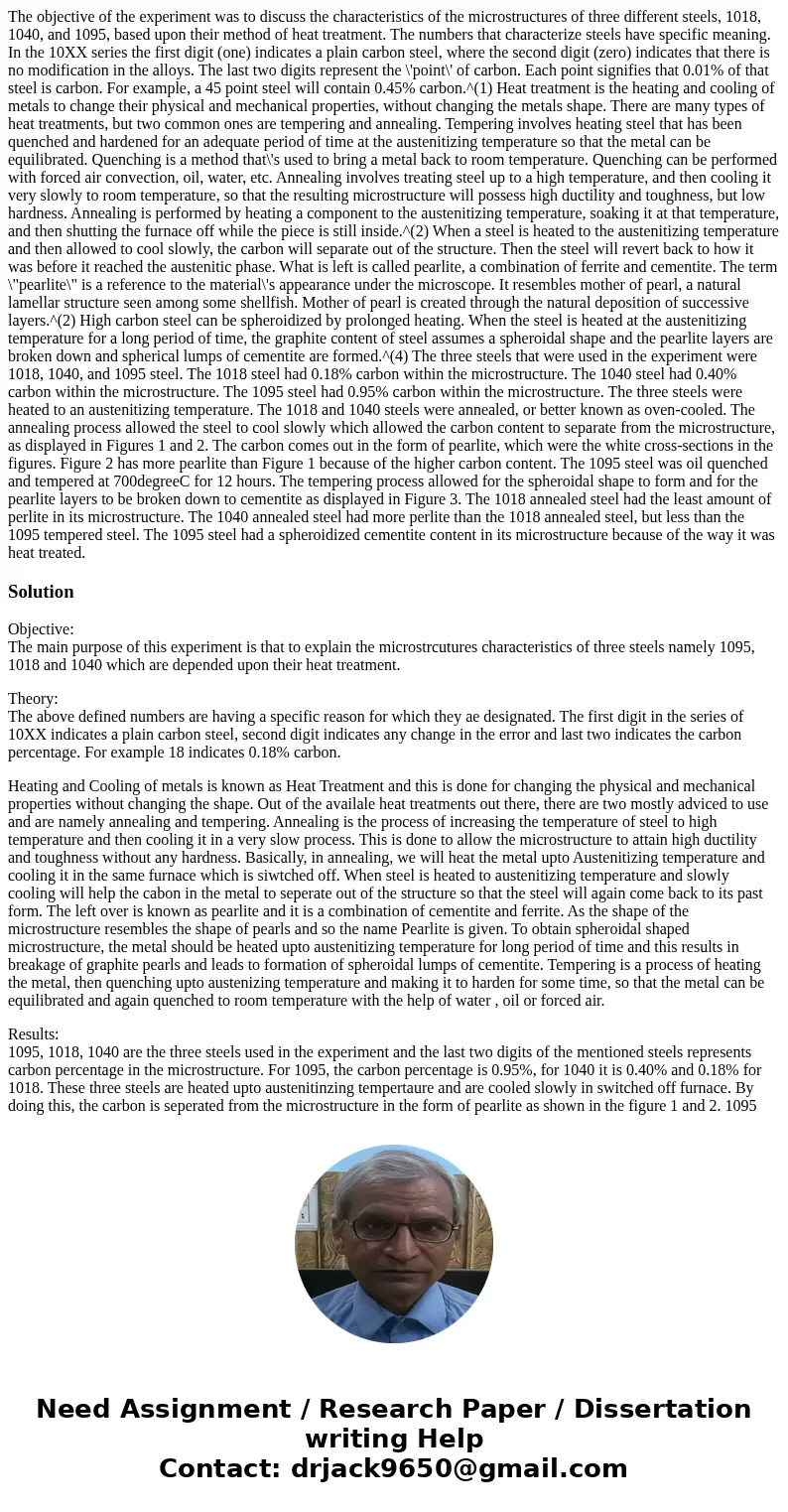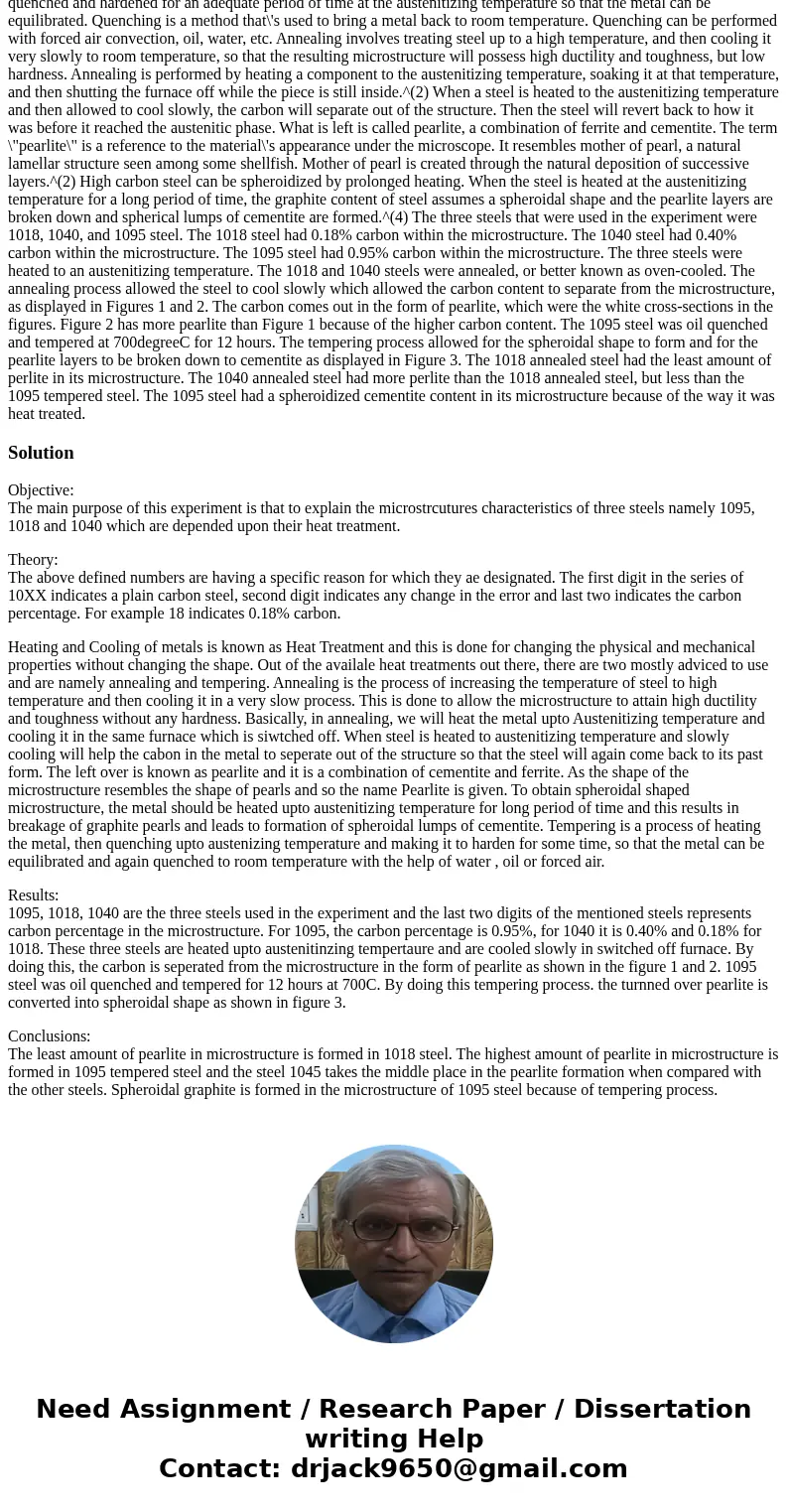The objective of the experiment was to discuss the characteristics of the microstructures of three different steels, 1018, 1040, and 1095, based upon their method of heat treatment. The numbers that characterize steels have specific meaning. In the 10XX series the first digit (one) indicates a plain carbon steel, where the second digit (zero) indicates that there is no modification in the alloys. The last two digits represent the \'point\' of carbon. Each point signifies that 0.01% of that steel is carbon. For example, a 45 point steel will contain 0.45% carbon.^(1) Heat treatment is the heating and cooling of metals to change their physical and mechanical properties, without changing the metals shape. There are many types of heat treatments, but two common ones are tempering and annealing. Tempering involves heating steel that has been quenched and hardened for an adequate period of time at the austenitizing temperature so that the metal can be equilibrated. Quenching is a method that\'s used to bring a metal back to room temperature. Quenching can be performed with forced air convection, oil, water, etc. Annealing involves treating steel up to a high temperature, and then cooling it very slowly to room temperature, so that the resulting microstructure will possess high ductility and toughness, but low hardness. Annealing is performed by heating a component to the austenitizing temperature, soaking it at that temperature, and then shutting the furnace off while the piece is still inside.^(2) When a steel is heated to the austenitizing temperature and then allowed to cool slowly, the carbon will separate out of the structure. Then the steel will revert back to how it was before it reached the austenitic phase. What is left is called pearlite, a combination of ferrite and cementite. The term \"pearlite\" is a reference to the material\'s appearance under the microscope. It resembles mother of pearl, a natural lamellar structure seen among some shellfish. Mother of pearl is created through the natural deposition of successive layers.^(2) High carbon steel can be spheroidized by prolonged heating. When the steel is heated at the austenitizing temperature for a long period of time, the graphite content of steel assumes a spheroidal shape and the pearlite layers are broken down and spherical lumps of cementite are formed.^(4) The three steels that were used in the experiment were 1018, 1040, and 1095 steel. The 1018 steel had 0.18% carbon within the microstructure. The 1040 steel had 0.40% carbon within the microstructure. The 1095 steel had 0.95% carbon within the microstructure. The three steels were heated to an austenitizing temperature. The 1018 and 1040 steels were annealed, or better known as oven-cooled. The annealing process allowed the steel to cool slowly which allowed the carbon content to separate from the microstructure, as displayed in Figures 1 and 2. The carbon comes out in the form of pearlite, which were the white cross-sections in the figures. Figure 2 has more pearlite than Figure 1 because of the higher carbon content. The 1095 steel was oil quenched and tempered at 700degreeC for 12 hours. The tempering process allowed for the spheroidal shape to form and for the pearlite layers to be broken down to cementite as displayed in Figure 3. The 1018 annealed steel had the least amount of perlite in its microstructure. The 1040 annealed steel had more perlite than the 1018 annealed steel, but less than the 1095 tempered steel. The 1095 steel had a spheroidized cementite content in its microstructure because of the way it was heat treated.
Objective:
The main purpose of this experiment is that to explain the microstrcutures characteristics of three steels namely 1095, 1018 and 1040 which are depended upon their heat treatment.
Theory:
The above defined numbers are having a specific reason for which they ae designated. The first digit in the series of 10XX indicates a plain carbon steel, second digit indicates any change in the error and last two indicates the carbon percentage. For example 18 indicates 0.18% carbon.
Heating and Cooling of metals is known as Heat Treatment and this is done for changing the physical and mechanical properties without changing the shape. Out of the availale heat treatments out there, there are two mostly adviced to use and are namely annealing and tempering. Annealing is the process of increasing the temperature of steel to high temperature and then cooling it in a very slow process. This is done to allow the microstructure to attain high ductility and toughness without any hardness. Basically, in annealing, we will heat the metal upto Austenitizing temperature and cooling it in the same furnace which is siwtched off. When steel is heated to austenitizing temperature and slowly cooling will help the cabon in the metal to seperate out of the structure so that the steel will again come back to its past form. The left over is known as pearlite and it is a combination of cementite and ferrite. As the shape of the microstructure resembles the shape of pearls and so the name Pearlite is given. To obtain spheroidal shaped microstructure, the metal should be heated upto austenitizing temperature for long period of time and this results in breakage of graphite pearls and leads to formation of spheroidal lumps of cementite. Tempering is a process of heating the metal, then quenching upto austenizing temperature and making it to harden for some time, so that the metal can be equilibrated and again quenched to room temperature with the help of water , oil or forced air.
Results:
1095, 1018, 1040 are the three steels used in the experiment and the last two digits of the mentioned steels represents carbon percentage in the microstructure. For 1095, the carbon percentage is 0.95%, for 1040 it is 0.40% and 0.18% for 1018. These three steels are heated upto austenitinzing tempertaure and are cooled slowly in switched off furnace. By doing this, the carbon is seperated from the microstructure in the form of pearlite as shown in the figure 1 and 2. 1095 steel was oil quenched and tempered for 12 hours at 700C. By doing this tempering process. the turnned over pearlite is converted into spheroidal shape as shown in figure 3.
Conclusions:
The least amount of pearlite in microstructure is formed in 1018 steel. The highest amount of pearlite in microstructure is formed in 1095 tempered steel and the steel 1045 takes the middle place in the pearlite formation when compared with the other steels. Spheroidal graphite is formed in the microstructure of 1095 steel because of tempering process.


 Homework Sourse
Homework Sourse